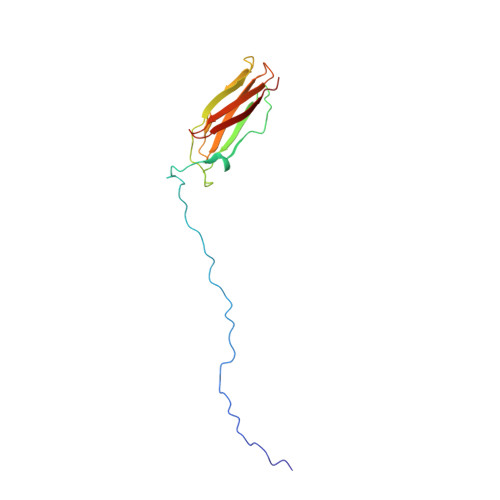The zinc regulated antivirulence pathway of salmonella is a multiprotein immunoglobulin adhesion system.
Prehna, G., Li, Y., Stoynov, N., Okon, M., Vuckovic, M., McIntosh, L.P., Foster, L.J., Finlay, B.B., Strynadka, N.C.(2012) J Biol Chem 287: 32324-32337
- PubMed: 22810234
- DOI: https://doi.org/10.1074/jbc.M112.357210
- Primary Citation of Related Structures:
2LV4 - PubMed Abstract:
The co-evolutionary relationship between pathogen and host has led to a regulatory cycle between virulence factors needed for survival and antivirulence factors required for host transmission. This is exemplified in Salmonella spp. by the zirTS antivirulence genes: a secretion pathway comprised of the outer membrane transporter ZirT, and its secreted partner, ZirS. ZirTS act within the gastrointestinal tract to function as a virulence modulator and during Salmonella shedding in anticipation of a new host. Together, ZirT and ZirS decrease virulence by lowering bacterial colonization at systemic sites through an unknown mechanism. To understand this mechanism, we have probed the zirTS pathway both structurally and biochemically. The NMR derived structural ensemble of the C-terminal domain of ZirS reveals an immunoglobin superfamily fold (IgSF). Stable isotope labeling by amino acids in cell culture experiments show that the ZirS IgSF domain interacts with its transporter ZirT, and reveal a new protein interaction partner of the pathway, a protein encoded adjacent to zirTS that we have designated as ZirU. ZirU is secreted by ZirT and is also a predicted IgSF. Biochemical analysis delineates ZirT into an N-terminal porin-like β domain and C-terminal extracellular soluble IgSF domain, whereas biophysical characterization suggests that the transporter undergoes self-association in a concentration-dependent manner. We observe that ZirS and ZirU directly interact with each other and with the extracellular domains of ZirT. Here we show that the zir antivirulence pathway is a multiprotein immunoglobulin adhesion system consisting of a complex interplay between ZirS, ZirT, and ZirU.
Organizational Affiliation:
Department of Biochemistry and Molecular Biology, University of British Columbia, Vancouver V6T 1Z3 BC, Canada.














